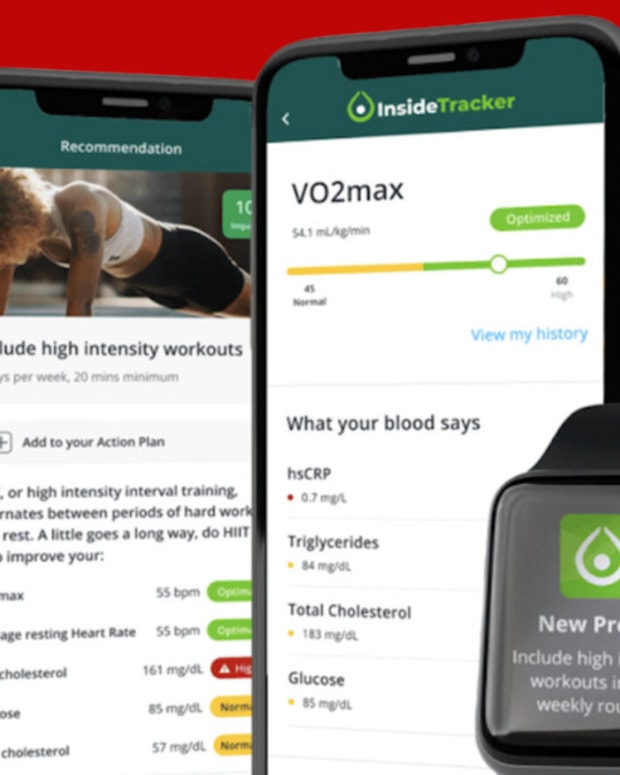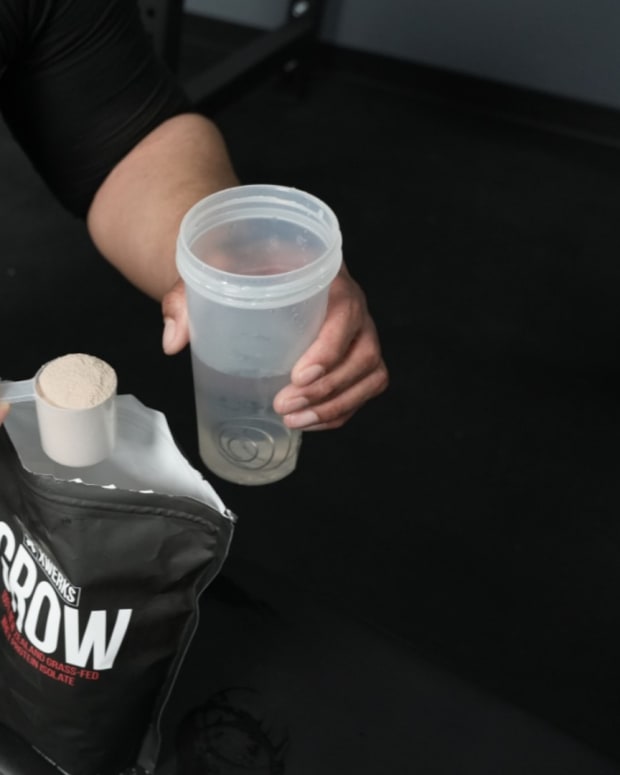The products featured in this article have been independently reviewed. When you buy something through the retail links on this page, we may earn commission at no cost to you, the reader. Sports Illustrated editorial staff are not involved in the creation of this content. Learn more here.
If you’re trying to lose weight, gain muscle or improve performance, someone somewhere has likely suggested you count macros (also known as macronutrients).
What are macros? Why would you want to track them? What’s the best macro diet—and how do you follow it? You’ll find those answers and more ahead. This guide explains what macronutrients are, walks you through the pros and cons of counting them and provides a step-by-step process for figuring out the best macro ratios for your wellness needs. Best of all, you’ll find ways to calculate the best macros ratios for you—without having to do a ton of math.
This content is meant to be informative, but should not be taken as medical advice. It is not intended for use as diagnosis, prevention or treatment of health problems. Always speak with your doctor before starting any new supplement or exercise regimen.
What Are Macros?
Short for “macronutrients,”macros represent the three main nutrients in food. They include:
- Proteins
- Carbohydrates
- Fats
They’re called “macros” because humans need them in large amounts. In contrast, micronutrients are vitamins, minerals and other nutrients that humans need in tiny amounts. For optimal health, humans need many grams of carbs of fats, carbs and protein. On the other hand, we only need milligrams or micrograms of micronutrients.
Most foods contain a mixture of two or more macronutrients. Because of that, nutritionists sort foods into “high protein,” “high carb” and “high fat” categories based on their primary or most abundant macro. Butter, for example, contains mostly fat, along with a tiny amount of protein. That’s why it’s considered a fat-rich food. Chicken breast, on the other hand, contains mostly protein, along with a much smaller amount of fat. As a result, it’s considered a protein-rich food.
The chart below can help you to understand, at a glance, what the three macronutrients do, along with the foods that contain them.
| Protein | Carbohydrate | Fat | |
|---|---|---|---|
Role in the body: | Builds and repairs muscle, tissues and organs | The body’s main source of energy | Broken down into fatty acids that help form important structures in the brain, nervous system and cell walls. Also involved in hormone production. |
Food sources: | Lean meat, poultry and lean dairy | Fruit, vegetables, grains, legumes, beans | Oils, nuts, seeds, butter, fatty dairy (example: cheese) and avocado |
Calories per gram: | 4 | 4 | 9 |
10 to 35 percent of your total diet | 45 to 65 percent of your total diet | 20 to 35 percent of your total diet |
Why Should I Track Macros?
Not everyone needs to track macros. Macros tracking tends to work best for certain populations of people, such as:
- People with diabetes who often track carbohydrates in order to keep their intake low enough for their bodies to process.
- Athletes, body builders and anyone else whose livelihood depends on them following a precise diet with strict macronutrient ratios.
- People who want to gain weight, as protein is especially important for building and preserving lean muscle tissue.
- People trying to lose fat, because adequate protein helps ensure you lose weight from fat rather than from muscle. It also helps to turn down appetite.
- Anyone following the keto diet or any other eating approach that recommends counting one or more macros.
If you have a history of eating disorders, disordered eating or any underlying health conditions it is important to discuss dietary changes with a doctor first, as closely tracking food intake may be triggering. Always consult with a medical professional before starting a new diet, exercise routine and/or weight loss program to ensure it’s right for you.
Calories vs. Macros: Which is Better?
When you track macros, you’re also tracking your calorie intake. That’s because your macronutrient goals are calculated based on your overall energy needs. In other words, your macro goals have calorie goals baked in.
With macros tracking, however, you’re doing much more than merely consuming enough food to gain weight, lose weight or maintain. You’re also ensuring you’re getting the right mix of protein, carbohydrates and fat for your goals, says Emily Field, RD, a macros-focused dietitian.
Let’s say you’re an endurance athlete. If you only tracked calories, you’d risk skimping on the carbohydrates you need to fuel those long cardio sessions. If you’re trying to gain weight, calorie counting won’t help you consume enough protein to build muscle. Similarly, if you have diabetes and only track calories, it would be easy to eat more carbohydrates than your body can handle.
The Healthy Plate vs. Macros: Which is Better?
The U.S. Government’s My Plate and Harvard’s Healthy Eating Plate represent simplified one-size-fits-all methods for macros-based eating. For many people, this simple approach is all they need.
That said, the plate isn’t personalized. Nor is it precise, says Field.
If you’re trying to achieve a specific goal—such as fat loss, muscle gain or improved athletic performance—macros tracking will likely take you where you need to go, Field says. “When tracking macros, you can better predict your results,” she says.
How to Calculate Macros
Generally speaking, you want 45 to 65 percent of your total calories to come from carbohydrates, 20 to 35 percent to come from fat, and 10 to 35 percent to come from protein. You’re probably thinking: “Wow, those ranges are huge. How do I know if I fall on the low or the high end for each macro?”
To sort that out, you’ve got a couple of options.
- The Easy Way to Calculate Macros, which relies on online calculators to do the math for you
- The Math-Lover’s Way to Calculate Macros, which will require many different mathematical calculations
Though the math-lover’s method will likely offer you more precise macro targets, try not to get too perfectionistic this early in the game, says Field. For most beginners, “It doesn’t really matter how you find your macro targets,” she says. “What matters is consistently hitting them for weeks and months. That’s what produces results.”
Disclaimer: If you’re looking for macro suggestions that are highly customized and targeted, you’ll likely need to consult with a registered dietitian. In addition to age, sex and activity level, RDs can factor in your dietary preferences, health goals, dieting history and a lot more. If you follow a strict diet (for example are a vegan or vegetarian) or your livelihood depends on you performing or looking your best, a consultation with a dietitian may be the way to go.
The Easy Way to Calculate Macros
If you’re not a fan of numbers, then you’ll want to use an online macros calculator. These handy digital tools will crunch all of the numbers for you, preventing you from having to do lots of calculations on your own. As an added bonus, some of them will also send you a menu plan to help you put your macros targets into action.
Here are a few to consider trying:
- Precision Nutrition Macros Calculator, which will transform your macros targets into an easy-to-follow eating plan complete with daily hand portions or protein, smart carbs, and healthy fats.
- IIFYM calculator includes a robust number of variables to spit out highly customized macros targets based on your overall health, activity level, eating style, and level of dieting expertise.
- Noom Macros Calculator is a highly personalized calculator that takes behavioral factors into its analysis. Note: You’ll want to devote five to 10 minutes to the intake.
The Math-Lover’s Way to Calculate Macros
Before you get started, you’ll want to know your height in centimeters as well as your weight in kilograms.
Step 1: Find your BMR.
BMR stands for “basal metabolic rate,” which is the number of calories your body burns at rest. There are several ways to determine BMR. Below, we’ve used the Mifflin-St Jeor Equation, which is thought to be the most accurate.
The BMR equation for women
(10 x weight in kilograms) + (6.25 x height in centimeters) - (5 x age in years) - 161 = BMR
For a 50-year-old woman who is five foot four inches tall (162.56 centimeters) and weighs 140 pounds (63.5 kilograms), the math looks like the below.
(10 x 63.5) + (6.25 x 162.56) - (5 x 50) - 161 = 1,240
The BMR equation for men
(10 x weight in kilograms) + (6.25 x height in centimeters) - (5 x age in years) + 5 = BMR
For a 30-year-old man who is six feet tall (182.88 centimeters) and 200 pounds (90.7 kilograms), the math looks like the below.
(10 x 90.7) + (6.25 x 182.88) - (5 x 30) + 5 = 1,905
Step 2: Calculate your total daily energy expenditure (TDEE).
Now it’s time to figure out how many calories you burn when you’re moving around, on top of your BMR. Use the chart below to pinpoint your activity level.
| Example | Activity Factor | |
|---|---|---|
Sedentary | No formal exercise | 1.2 |
Lightly active | Light waking or housework, 1 to 3 days a week | 1.375 |
Moderately active | Moderate exercise 3 to 4 days a week | 1.55 |
Active | Moderate to vigorous exercise 5 to 6 days a week | 1.725 |
Very active | Vigorous exercise 6 to 7 days a week | 1.9 |
Plug your activity factor into the equation below to determine your total daily energy expenditure.
BMR x Activity Factor = TDEE
For example, let’s say the 50-year-old woman mentioned above is “moderately active.” The math for her would look like this:
1,240 x 1.55 = 1,922
Another example: If the 30-year-old man from above is sedentary:
1905 x 1.2 = 2286
(By the way, if you’re thinking that 1,922 sounds like a lot of calories for a 50-year-old woman, know that many people try to subsist on a lot less—often 1,400 or 1,200 daily calories. Problem is, they end up intensely hungry and tired, with cravings that won’t quit. As a result, though they’re trying to consume 1,200 or 1,400 calories, they end up snacking so much that their daily total consistently goes above 1,900, says Field.)
Step 3: Figure out your macros
Use the formulas below to pinpoint how many grams of carbs, fats and protein that your body needs in a typical day.
| Protein Intake | Carbohydrate Intake | Fat Intake | |
|---|---|---|---|
Calories per day | TDEE x .30 | TDEE x .35 - .45* | TDEE - [(protein grams x 4) + (carbs x 4)] |
Grams per day | (Answer from above) ➗4 | (Answer from above) ➗4 | (Answer from above) ➗9 |
* Choose .45 if you love carbs, do a lot of high-intensity cardio, or prefer a vegetarian or vegan eating pattern. Choose .35 if blood sugar issues are a concern.
Once you’ve calculated your daily macros, stick with it for at least a few weeks. Then iterate from there, suggests Toronto-area dietitian Andy De Santis, RD, MPH. If you’re still hungry between meals or struggling to recover after workouts, you might bump up your protein, he says. Maybe you supplement your diet with protein powder or protein bars, for example.
Related Post: The Best Protein Powders for Weight Loss
On the other hand, if you’re hitting the wall during long endurance efforts, you might want to bump up your carbs instead. By experimenting and iterating over time, you’ll eventually come up with macro targets that are highly personalized for your specific needs.
Benefits of Counting Macronutrients
The biggest benefit of macros tracking: The method helps to ensure you’re getting enough protein.
“Protein is essential for metabolism and muscle maintenance,” says De Santis. “Protein-rich foods also tend to come paired with iron and other micronutrients that people need. It also makes you feel more full and requires more energy to break down than does carbohydrates or fat.”
On top of that, some fitness goals are contingent on precise intakes of protein, carbs and fats. As we mentioned earlier, endurance athletes usually need more carbs, whereas bodybuilders need more protein.
Macros tracking isn’t for everyone, however. The method works best for people who are naturally curious about the calories, macronutrients and micronutrients in their foods, says De Santis. Macros counting is perfect “for people who love numbers,” he says.
Drawbacks of Counting Macronutrients
There’s no getting around this: When you decide to track macros, you need to plan, measure and record what you eat. This generally involves reading nutrition labels, as well as using measuring tools, along with a food scale to ensure you’re consuming the right portion sizes for your macro goals.
All of this requires a lot of precision—and life isn’t always precise. If you want to have a robust social life and don’t want to eat most of your meals at home, you may need a more flexible dieting approach, says De Santis.
That said, there are ways to make macros counting a lot easier. See “how beginners count macros” below for ways to get the benefits of macros tracking with less effort.
How to Count Macros for Weight Loss
To lose body fat, you’ll need to create a calorie deficit.
Subtract 10 to 20 percent from your calorie expenditure in Step 2 from above. For example, if the 50-year-old woman from above wanted to lose weight, she’d subtract 10 percent from her calorie expenditure. The equation would look like this:
1,922 - 192 = 1,800
From there, she’d use “1,800” as her TDEE in step 3.
How to Count Macros for Weight Gain
If you’re hoping to gain muscle mass, you’ll want to create a 10 to 20 percent surplus. Let’s say our 30-year-old man wants to pack on some muscle. He’d probably want to adjust his activity level from sedentary to at least moderately active, depending on how much time he plans to spend in the gym.
That looks like the below:
1,905 x 1.55 = 2,952
Then he’d want to add at least 10 percent.
2,952 + 295 = 3,247
After that, he’d use 3,247 as his TDEE in step 3 from above.
How to Count Macros for Cutting
When cutting for a bodybuilding competition, you’ll want to maintain your protein target in order to help preserve muscle tissue, says De Santis. Instead, to shed fat, try to reduce calories from either your fat or carbohydrate targets. According to some research, you’ll want to aim for the following ratio.
Protein: 30 percent
Carbohydrate: 55 to 60 percent
Fat: 10 to 15 percent
How to Count Macros for Keto
The keto diet relies on counting just one of the three macros: carbs. As long as you keep carbohydrate intake below 40 to 50 daily grams, you don’t have to count the other macros, says keto nutritionist Valerie Goldstein, MS, RD. An easy way to ensure you stay on the keto diet: Sign up for a keto meal delivery service that delivers meals that adhere to the keto parameters to your doorstep.
Tracking Alcohol
Because protein is the more important of the three macronutrients, you’ll want to budget alcohol as either a carbohydrate or fat (or a combo of the two), says Field.
Whether you count it as a carb or fat will likely depend a lot on your food preferences, she says. If you love starches, for example, it might be easier for you to eat less fat in order to work alcohol into your diet. On the other hand, if guac is your bestie, you might want to count alcohol as a carb.
The Best Ways to Track Macros
To make macros tracking easier, you’ll want to use an app. Below are the three of the best macro tracking apps out there:
- Cronometer: The free version of this app allows you to log meals as well as set your macros. It will also pair with a wearable fitness tracker to track your energy expenditure.
- MyFitnessPal: Provides the calorie and macros breakdowns of millions of foods, along with a food diary that helps you log what you eat. The app allows you to scan barcodes to quickly input data from packaged foods.
- Carb Manager: Though this app will track all three macros, it’s primarily focused on carbs. That’s because it’s designed for people who are following low-carb and keto diets.
In lieu of the above, if fat loss is your goal, you might want to look into a weight loss app instead.
Macro Counting FAQs
How do beginners learn to count macros?
If you’re just getting started, know that you don’t have to track all three macros to see benefits, says Field. Consider one of the following scaled down options:
Write down what you eat: The simple act of logging your food intake can help you get in the habit of logging in general. Plus, it makes you more aware of your food choices, says Field.
Track protein: As we mentioned, of the three macros, protein is the most important to get right. As a result, consider tracking only your grams of protein grams during the day, says De Santis.
Track protein plus calories: If you’re trying to lose or gain weight, you might want to include your overall calories, in addition to your grams of protein, says Field.
What macros do you burn first?
To fuel your body and brain, your cells will initially use up stores of glucose (a type of carbohydrate) from your blood as well as glycogen (a form of carbohydrate that’s stored in your liver and muscles). As it runs low on those fuel sources, it will dip into stored fat. Your body will minimize using protein as a fuel source.
How much protein is too much?
Most people eat too little protein rather than too much, says Field.
“In my 10 years of working with clients, I’ve never seen signs of someone getting too much protein in their diet,” says Field, “but I often see clients not eating enough protein.”
The recommended dietary allowance (RDA) to prevent deficiency for an average sedentary adult is 0.8 grams of protein per kilogram of body weight. This means that for a man who is 175 pounds, about 60 grams of protein are needed per day to prevent deficiency. “This should be considered an absolute baseline and not at all close to the amount per day to optimize health, body composition and athletic performance,” says Field.
According to the National Academy of Sports Medicine, people trying to build muscle need a lot more than that, in the neighborhood of 1.6 to around 2.2 grams per kilogram of body weight, depending on their activity level. For the same 175-pound man, that works out to 126 to 174 grams of protein a day.
Given that four ounces of chicken breast provides about 31 protein grams, you can get a sense for how easy it is for people to eat too little, especially if they don’t eat meat. If that's the case, you can supplement with protein powder.
With that huge caveat out of the way, let’s talk about what happens when you get too much.
Theoretically, kidney issues might be a concern for people consuming high amounts of protein, but only if they have existing kidney disease. In healthy people, there are more dangers to consuming too little protein than for consuming too much, according to research.
Related Post: The Best Protein Powder for Weight Loss?
How do I create a macro meal plan?
To figure out what to eat, the macro-tracking apps mentioned earlier can help. So can the Healthy Plate concept. Once you know your macros split, consider modifying Harvard’s Healthy Eating Plate to fit your specific macros goals. This will help you to better visualize and plan each meal.
Another option: Convert your grams of macros into hand portions, suggests Field. For help, use the chart below.
| 25 Grams Protein | 25 Grams Carbs | 15 Grams Fats |
|---|---|---|
- One palm of meat, fish, or poultry | - One fist berries, non-starchy veggies | - One thumb of butter, oil |
What macro burns the most calories?
When you eat, your body burns calories to fuel digestion, absorption, and metabolism. This is known as the “thermic effect of food.” It accounts for about 10 percent of your overall energy expenditure. Protein makes up 20–30 percent of TEF, carbohydrate five to 10 percent of it, and fat up to three percent of it.
Prices are accurate and items in stock as of publish time.









